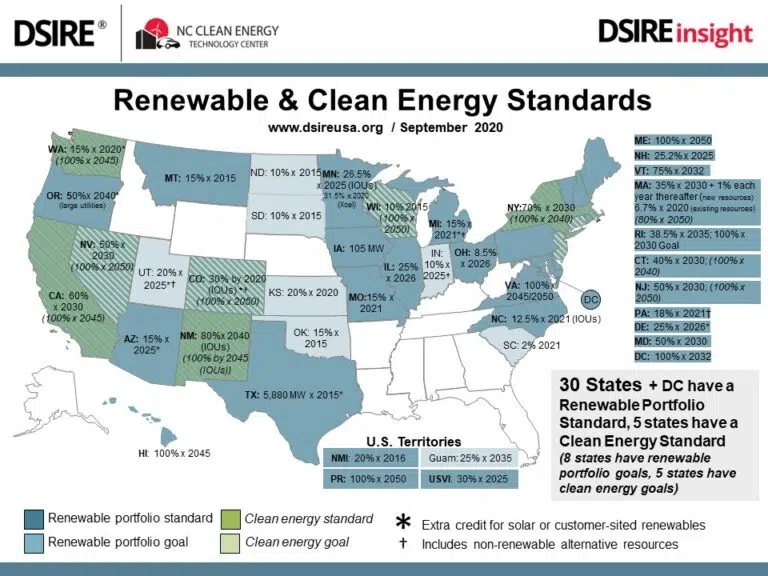Blog
The Evolution of Clean Energy Regulation
December 15, 2022
Part One: Where Renewable Portfolio Standards Fell Short
Clean energy regulations began in the 1980s. These policies have helped the power sector reduce carbon emissions by over 25%. However, as utilities and policymakers revisited the impact of their early policies and regulation, they noticed a need for wider and greater regulatory framework. This is a three-part series focusing on the evolution of clean energy policy, with a focus on Washington State. We will offer insight into early renewable energy regulation and its shortcomings and provide a case study about Washington’s (WA) groundbreaking Clean Energy Transformation Act (CETA).
Included In This Series
- Early Clean Energy Regulation: Where Renewable Portfolio Standards Fell Short
- Clean Energy Regulation Revamped: Case Study of the Washington (WA) Clean Energy Transformation Act
- Implementing New Clean Energy Regulation: WA CETA Case Study
Early Clean Energy Regulation: Where Renewable Portfolio Standards Fell Short
U.S. states began the regulatory push to transform the energy sector through passing renewable and clean energy standards. These standards mandated that a specific percentage of electricity utilities sell comes from renewable/clean energy resources. The first Renewable Portfolio Standard (RPS) was passed in 1983 in Iowa. Today, a majority of states have a RPS (see Figure 1). These standards have played an important role in driving down the cost of renewables, increasing public perceptions of solar and wind, and creating conducive regulatory framework. They also have helped to create thousands of jobs and driven economic development. The carbon intensity of the US electric grid is decreasing. While version 1 of clean energy regulation has driven significant change in the energy sector, the limitation of this regulation is now recognized.

Figure 1 Renewable & Clean Energy Standards Map. Source: DSIRE
Even as early clean energy regulation helped to drive a significant increase in renewable energy penetration, three challenges rose to the surface: climate, equity and infrastructure capacity.
Climate
Transitioning energy generation to renewable resources is a crucial element in the fight against climate change. However, focusing exclusively on kilowatt-hours (kwh) does not take into account that certain renewable sources are not available 24/7. California’s well-known “duck curve” showed us that the trends for solar generation and electricity consumption may be misaligned. Peaker plants may be utilized to meet peak demand needs not are not met by renewable energy. Peaker plants are often old and inefficient, which means they are high emitters of greenhouse gas emissions and costly. They are disproportionately located in low-income neighborhoods of color, where they emit large amounts of harmful pollutants.
Equity
Disadvantaged populations are disproportionately impacted by climate change. Marginalized populations are the least likely to prepare for and recover from, heat waves, poor air quality, flooding, and other climate related disaster. Regulation that focuses exclusively on renewable energy generation fails to incorporate equity into the equation.
Extreme heat events and grid outages also have a disproportionate impact on disadvantaged and lower income populations, making resiliency and ability to deal with extreme weather an equity issue.
Infrastructure upgrades required for the clean energy transition may result in an increased cost of electricity, further elevating the energy burden[1] on low-income households.
Therefore, it is imperative to use an equity lens when addressing the climate crisis through the clean energy transition.
Infrastructure Capacity
The grid was not built to handle extreme weather events that are becoming increasingly common throughout the country. The summer 2021 extreme heat event, or “heat dome,” in the Pacific Northwest broke records for summer and peak electric loads. Residents of Washington State experienced unprecedented outages due to the heat dome.
Built centuries ago for centralized generation resources and one-way power flow, the outdated US electric grid infrastructure is delaying in the clean energy revolution. Unable to handle decentralized generation or two-way power flow, the grid is hindering the adoption of Distributed Energy Resources (DERs). DERs represent a host of technologies and practices largely on the customer side of the meter. DERs include resources such as on-site renewable energy, energy storage, enhanced building controls, and electric vehicles. The electrification of buildings and transportation combined with increasing extreme weather events, will only further expose the limitations of the grid’s infrastructure.
Clean Energy Regulation, Revamped
State regulators realized that clean energy regulation provides an opportunity to address the climate and equity crises. Thirteen states and District of Columbia have climate goals that include by no later than 2050:
- At least 75% reductions in greenhouse gas emissions; and
- At least 75% of electricity production from renewable or combined renewable and clean energy production.
Washington State is one of the leaders in terms of passing transformed clean energy regulation which addresses both climate and equity. In 2019, WA passed the Clean Energy Transformation Act (CETA), or SB 5116. We will explore CETA’s uniqueness in Part 2 and 3 of this blog series.
[1] Energy burden is defined as the percentage of gross household income spent on energy costs.
Stan Price, Alicia Noriega, Kalea Fajarillo, and Rishabh Mallick were contributors to this series.